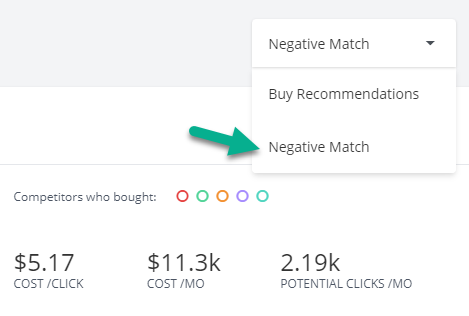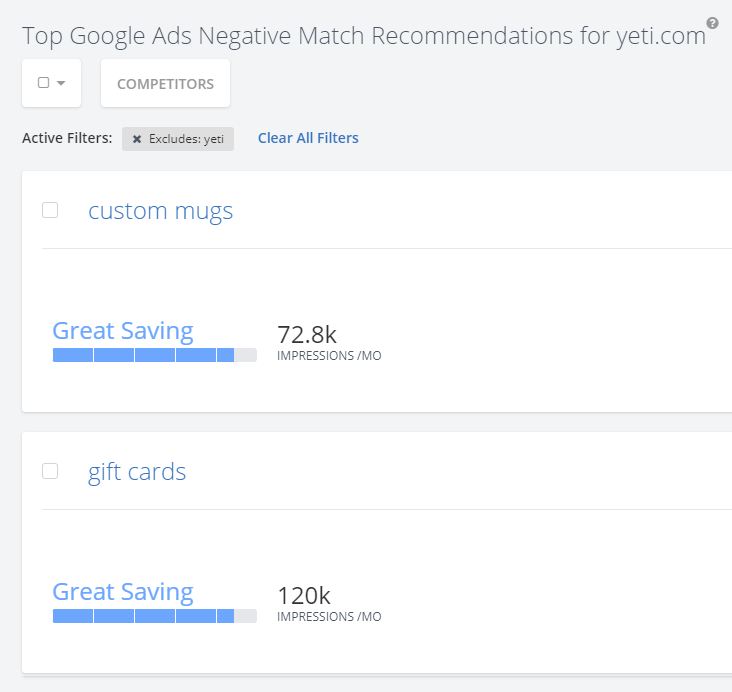Their name sounds like the worst parts of your campaign, but negative keywords can save your budget and your quality score.
Negative keywords focus your ad spend by telling companies like Google and Microsoft what keywords you don’t want your advertising dollars spent on. They’re the secret sauce to creating a lean, mean online advertising campaign.
Use negative keywords to make the most of your search ad spend. You’ll avoid investing in pointless ads and gear your promotion toward searchers who are interested in your content.
By 2025, businesses are forecasted to spend over $211,000,000,000 on search advertising. Unfortunately, a lot of this spend will be wasted. Based on their client data, the marketing agency Seer Interactive found that 5% to 20% of search ad budgets go toward keywords that perform poorly.
One way businesses can reduce wasted search ad spend? Use negative keywords.
What Are Negative Keywords?
Negative keywords are used in online advertising to exclude certain keywords from displaying your ads. A good negative keyword strategy works in concert with your normal keywords to increase the chances of your ads appearing in valuable searches. Say you run a company that sells decorative maps of American cities. You may want to target keywords like:
- Decorative maps
- Gift maps
- Decorative map of New York City
You want to target people looking to buy a map to put on display, but you don’t want to put your ads in front of people looking for maps to navigate. You also want to make sure that your ads are for decorative maps of American cities since these are the ones you sell.
To remove your maps from cities and regions that you don’t serve, you could use negative keywords like:
- Paris
- London
- Europe
- Asia
To avoid searches for navigational maps, you could use negative keywords like:
- Tourist map
- Google Maps
- Directions
By growing your negative keyword list alongside your targeted keyword list, you can direct your ads toward audiences that will find them helpful.
Why Are Negative Keywords Important?
Negative keywords let you present your ads to audiences that will find them relevant. This tactic doesn't just help you boost traffic. It also improves your click-through rates (CTRs), which help boost your ad's visibility and lower its overall cost.
Say the mattress company Purple wants to increase sales by running targeted ads. They begin running ads on some of their main keywords, and after a couple of weeks, they check in to see how the campaign is doing.
They realize that some ads are matched with relevant phrases, but others are matched with keywords that aren’t related to buying mattresses:
- Best beds for dogs (isn’t related)
- Purple (is ambiguous)
- Alternatives to Purple mattresses (not looking to buy)
- Nectar vs. purple (isn’t related)
The ads on these keywords all have bad CTRs because they aren’t relevant to searchers who are looking to buy a Purple mattress.
So, how does this affect Purple and their ad campaign?
- Wasted money. Although these ads aren’t useful, they still may be clicked by accident. Each click represents wasted pay-per-click (PPC) ad money that could be better used elsewhere.
- Increased price of bids across the campaign. Your Google ad’s actual cost-per-click (CPC) is impacted by your Ad Rank, which is partially determined by your ad’s CTR. So when your CTR goes down (due to poorly placed ads), your overall Ad Rank will likely go down as well. A low Ad Rank correlates with a higher actual CPC—all because your ads are being placed in the wrong search queries.
Negative keywords help marketers make the most of their search ad spend. Setting up ads to avoid these phrases starts with building negative keyword lists.
Create Your Negative Keyword Lists
Just like regular keywords, you can’t just brainstorm for five minutes to come up with negative keyword lists. You’ll need to spend some time brainstorming and using data to make these lists as comprehensive as possible. Here is where we would start to make the best possible list of negative keywords for your PPC campaign.
Add General Negative Keywords
There are some keywords that you wouldn’t want to target in most situations. Start by focusing on these more obvious phrases. Consider negative keywords that:
- Are irrelevant location keywords. There are 29 places named London in the world; for “best plumbers in London,” you can use negative keywords to avoid having your ad shown in areas where you aren’t located.
- Are intended to navigate to other websites. If you are a food blog promoting your chicken parmesan recipe, you may not want your ad on searches looking for “bon appetit chicken parmesan recipe.”
- Are inappropriate or illicit. This includes any keywords that might associate your brand with negative feelings. For example, if you sell knives, you may not want your ads coming up on stories about stabbing victims.
- Are employment-related (unless you want that). If you’re a plumber selling your services, you don’t want an ad for your business to show up for someone looking to become a plumber.
- Are ambiguous or misspelled. A company specializing in ice hockey equipment could use negative keywords to make sure that their ads don’t get placed on keywords having to do with field hockey.
Consider these negative keywords as your starting point. From here, you can use tools and data to help you find other useful negative keywords.
Check Related Keywords
Just like searching for regular keywords, you can use keyword research tools to find related phrases for short-tail negative keywords, as well.
Any keyword tool should work, but we will be demonstrating with SpyFu’s Related Keywords tool. There is a limited-use free version if you aren’t already using the tool and want to follow along. If you prefer, you can also use Keyword Planner to find related keyword terms.
Start by plugging in your short-tail keyword to get a list of related search terms. In our example, we have used the keyword “beach umbrella.”

Next, you can begin to check the box beside any keyword that you think:
- isn’t relevant
- won’t lead to a good conversion rate
Even with a straightforward keyword like “beach umbrella,” you can find keywords that you definitely don’t want any ads placed on.
When you are done, click export to download, and you will have a handy CSV file to add to your existing negative keyword list.
Get a List of Recommendations Specific to Your Domain
If you have already been running search ads on Google, you can pull a domain-specific report that lists negative match recommendations. The Google Ads Advisor inside SpyFu aims to save your budget by cutting out potentially wasteful keywords that have been triggering your ad, but not your competitors.

That's the twist. We believe that if none of your competitors are taking a shot at a keyword that you're buying, they might have already learned that this search term doesn't convert well enough to justify the cost.
One exception to that rule is that you have reason to buy your branded terms far more than they do. You can keep your branded terms out of our negative match recommendations by using the "exclude" filter to leave out products or your name.

If we run a negative match recommendation report for yeti.com, it makes sense to exclude "yeti" from the suggestions we get back. The results include non-branded terms that yeti.com is buying, but no close competitors advertise on.

Explore the Search Terms Report
You can take a similar route in Google, using the engine’s search terms report to see which keywords your ads have appeared on. Review the list to see if any keywords aren’t relevant or aren’t performing well enough, and add them to your negative keyword list.
To get to Google’s search terms report:
- Open your Google Ads (formerly Google AdWords).
- Select the Campaigns you want to see data on.
- Click on Keywords on the left-sidebar.
- Choose Search Terms.
From here, you can explore any search terms your ads have been displayed on. You can also filter by conversion rate or interaction rate to see which ads aren’t leading to results.
From this screen, you can also directly add negative keywords to your campaigns by selecting the search term and then clicking “Add as a negative keyword” in the blue bar at the top of the table.
Hidden Search Terms
Just a side note, this search term view is incredibly valuable, but it's not 100% indicative of every search. We learned that Google hides some of the lower-volume terms that people searched before clicking your ad. Since that information is helpful for weeding out terms to set to negative match, we suggest this potential workaround.
Bing Ads
If you are advertising on Microsoft (Bing Ads), you can also access their Search Terms Report for negative keyword data by:
- Clicking on Reports (at the top of the page)
- Selecting Reports from the dropdown menu
- Selecting Performance (on the sidebar)
- Clicking on Search term
From here, we can start learning how to implement our negative keyword lists.
Add Negative Keywords to Your Google Ads Campaign
To start adding negative keywords to Google Ads :
- Click on Keywords.
- Click on Negative Keywords.
- Click on the “+” symbol.
Once you have reached that page, you can add individual keywords to a campaign, an ad group, or a negative keyword list.
Keyword lists can be useful if you plan on applying the same negative keywords to multiple campaigns or ad groups. This will save you time as you won’t have to set each negative keyword for each new campaign or ad group you make.
Setting Ad Group and Campaign-Level Keywords
When applying negative keywords or negative keyword lists, you need to decide whether you want them applied to whole campaigns or individual ad groups. You want to apply negative keywords on the campaign level when they are:
- Ambiguous or inappropriate in general
- Related to your product but not appropriate for this campaign
On the other hand, adding negative keywords at ad group levels can be useful for:
- Targeting ad groups to specific audiences
- Limiting your ad’s reach to only encompass what you are selling
Say you have an ad campaign designed to drum up sales for your board game business during the Christmas season. You have designed several ad groups: one is targeted at couples looking for gifts, and one is aimed at parents buying presents for their children.
Both ad groups want to target the broad match keyword of “Christmas gift ideas.” But to make sure that the right ad goes to the right audience, you could add these negative keywords:
| Couples | Parents | |
|---|---|---|
| child | boyfriend | |
| children | girlfriend | |
| kid | engagement | |
| son | significant other | |
| daughter |
With these negative keywords, you could be more confident that the ad groups will reach their correct audiences. Once you have decided whether your negative keywords will be applied at the campaign level or the ad group level, you need to determine how Google will apply them by selecting their match types.
Using Match Types: Broad Match, Phrase Match, and Exact Match
Keyword match types tell Google how strictly you want them to apply your keyword in their algorithm. There are three keyword match types that can be applied:
- Broad Match: Google will match your keyword with related terms.
- Phrase Match: Google will match your keyword with other keywords that include the meaning of your keyword (but may also include other information as well).
- Exact Match: Google will only match with keywords that have the same meaning as your keyword.
However, these terms are slightly different when applied to negative keywords:
- Negative Broad Match: Google won’t show ads on keywords that contain all of the negative keyword terms (regardless of the order in which they come in).
- Negative Phrase Match: Google won’t show ads for keywords that contain the negative keyword phrase in the same order as you put it.
- Negative Exact Match: Google will only exclude that exact keyword.
To see this at work, here is an example of what would and wouldn’t show up if your negative keyword phrase was “gaming computer.”

To use these different matching types, you also need to know the notation Google uses to input negative keywords.
- Negative Broad Matches are the default option, so you do not need to add any notation when adding them. (Example: gaming computer)
- Negative Phrase Matches are put inside quotation marks. (Example: “gaming computer”)
- Negative Exact Matches are placed inside brackets. (Example: [gaming computer])
With these match types, you can now begin to add negative keywords to your search campaigns.
Negative Keywords on Display and Video Campaigns
On display and video campaigns, negative keywords work a little differently. You can’t specify match types with these kinds of campaigns. Instead, Google will try to remove web pages that fit the idea you are describing with your negative keyword.
If you use the negative keyword phrase “gaming computer” in these kinds of campaigns, web pages about gaming computers will be excluded. Web pages not about gaming computers but containing the phrase “gaming computer” will not be excluded.
Overall, negative keywords are less exact when applied to display and video campaigns. However, negative keywords can still help to make them as targeted as possible.
Using Negative Keywords with Microsoft Advertising
If you use Microsoft Advertising, there is only one big difference you need to be aware of—there are no negative broad match keywords. If you are copying negative keyword lists over from Google Ads, make sure to account for this change.
How Do You Add Negative Keywords or Keyword Lists?
To add a negative keyword or modify/create a negative keyword list on Microsoft Advertising, follow these instructions.
To add a negative keyword:
- Click on All campaigns.
- Select Keywords from the menu.
- Choose Campaign or Ad group.
- Select Add negative keywords.
- Choose the ad group or campaign you want to add to.
To create or add to a negative keyword list:
- Click on Tools (beside Reports at the top of the screen).
- Click Negative keyword lists under the Shared Library section.

3. On the next page, click on “Create negative keyword list” or select an existing negative keyword list to begin adding to or editing the list.

For more explanation on how to implement negative keywords on Microsoft, you can refer to their negative keywords instructions.
Taking Your PPC Game to the Next Level
A strong PPC campaign is built on relevant, high-traffic keywords—but it’s not the only factor in successful online advertising. Negative keywords are also necessary to prune back the excess that can run rampant through pay-per-click advertising. They're the yin to your target keywords' yang.
When you balance these two kinds of keywords correctly, you can take back control of your ad spend. To make sure your ads are only appearing on the most relevant web pages or search queries, you should continually update your negative keyword lists and check your search terms reports. Make this a weekly or bi-weekly habit, and you’ll quickly see how much of your ad spend you can keep in your own pockets and allocate to stronger terms.

